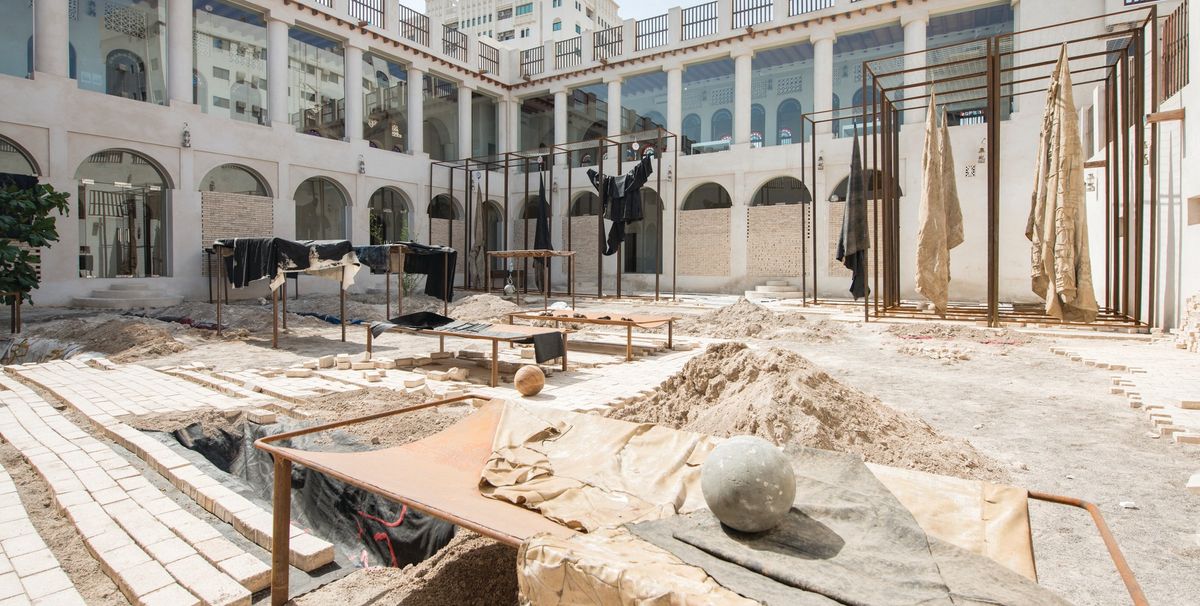The Sharjah Biennial is the jewel in the crown of non-commercial contemporary art events from the Maghreb to the Gulf. After editions with curators from Japan and the US, this, the 13th, has Christine Tohme from Lebanon. She is the widely respected founder of Ashkal Alwan, an art centre that is home from home for artists, a discussion forum, and a research and exhibition space.
Tohme is an activist who says she spends 50% of her time on visa issues, 50% on finding money and another 50% helping her artists enjoy themselves. Never afraid to acknowledge the elephant in the room, at the packed opening she admitted her doubts: “I do not know who our audience is; is it you lot in front of me? This model is not working.”
One of her solutions to this question has been to give the biennial satellites: in Dakar, Istanbul and Ramallah, with the closing event in her hometown of Beirut this October.
Her title, Tamawuj, means fluctuation, coming and going, but she has also evolved four solid key words in discussion with her partners, the artist Kader Attia and curators Lara Khaidi and Zeynep Oz: water, earth, crops and cooking.
As in past years, most of the event takes place in the courtyard houses of historic Sharjah, down by the creek: the Al Mureijah Square buildings, the Calligraphy Square and Arts Square. The Flying Saucer and Planetarium house other works of art, while 19 works are situated in the new Hamriyah Studios, about 20 minutes out of Sharjah.
Due to US President Trump’s unscientific denial of the importance of ecology, the works that deal with that subject resonate strongly. One that offers some hope is the 2014 video piece in the Hamriyah Studios by Ursula Biemann and Paulo Tavares about lawsuits brought against unscrupulous companies that are wrecking the virgin jungles of Ecuador. I learned that a Native American tribe has recently won its case by invoking the Rights of Nature clause in Ecuador’s 2008 Constitution, which leads the world in recognising nature as having rights equal to human rights.
Palestine is an unhealing wound and it is symbolised in Al Mureijah Square by a fictional Palestinian museum of natural history. Among the “exhibits” is a blue, undulating floor sculpture that turns out to be a model of the Dead Sea. After the 1995 Oslo Agreement, part of its waters were allocated to the Palestinians and part to the Israelis, but the waters are drying up most rapidly at the Palestinian end and the Israelis are claiming it, inch by inch, as it turns into dry land.
The turmoil and agony of the rest of the Middle East is also present sometimes by allusion, sometimes overtly. A harrowing sound piece by Lawrence Abu Hamdan is located in Calligraphy Square. In 2016, he worked with Amnesty International and recorded former inmates of the Syrian government prison called Saydnaya, where, it is estimated, 13,000 were executed. The particular form of torture there was a viciously imposed silence, even a cough from one of the cells leading to a severe beating. There are no actors’ screams of agony here, just the voices of the victims telling their story.
Tohme is right to ask who the audience is, because there is a fundamental communication problem deriving from the fact that “contemporary art” is an import from the West. The words for nearly every concept within it do not have Arabic equivalents; for example, there is not even an agreed word for curator. So the Sharjah Art Foundation has commissioned a video called “Institutional Terms” from Fehras Publishing Practices, which is about the fact that in the 1980s and 90s, a dictionaries of art and architecture terms were compiled in Egypt to try to make up for this absence. But these have already been superseded by what has happened in the art world. A comatose body lies on a slab while technicians stick a funnel in his mouth and prepare to pour in a green potion of foreign words. The question is: will he spring to life?


